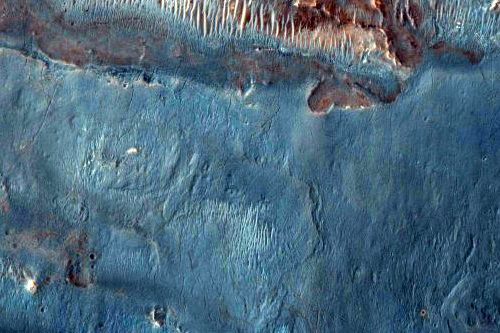[/caption]
Data from the Mars Reconnaissance Orbiter suggests that there could be habitable environments underground on Mars – in the past, and perhaps even today. Scientists discovered evidence of long-sought-after hydrothermally altered carbonate-bearing rocks which were once deep within the Red Planet, exposed within an impact crater. “Carbonate rocks have long been a Holy Grail of Mars exploration for several reasons,” said Joseph Michalski from the Planetary Science Institute. He explained that on Earth, carbonates form with the ocean and within lakes, so the same could be true for ancient Mars. “Such deposits could indicate past seas that were once present on Mars. Another reason is because we suspect that the ancient Martian atmosphere was probably denser and CO2-rich, but today the atmosphere is quite thin so we infer that the CO2 must have gone into carbonate rocks somewhere on Mars.”
This unique mineralogy was spotted within the central peak of a crater to the southwest of a giant Martian volcanic province named Syrtis Major. With infrared spectra from the Compact Reconnaissance Imaging Spectrometer for Mars (CRISM), planetary geologists detected the hydrothermal minerals from their spectroscopic fingerprints. Visible images from the HiRISE camera (High Resolution Imaging Science Experiment) on board MRO show that the carbonates and hydrated silicate minerals occur within deformed bedrock that was exhumed by an ancient meteor impact that poked through the volcanic upper crust of Mars.
The carbonate-bearing rocks were once likely about 6 km (about 4 miles) underground. The carbonate minerals exist along with hydrated silicate minerals of a likely hydrothermal origin.

While this is not the first detection of carbonates on Mars, Michalski said, “This detection is significant because it shows other carbonates detected by previous workers, which were found in a fairly limited spatial extent, were not a localized phenomenon. Carbonates may have formed over a very large region of ancient Mars, but been covered up by volcanic flows later in the history of the planet. A very exciting history of water on Mars may be simply covered up by younger lava!”
The discovery also has implications for the habitability of the Martian crust. “The presence of carbonates along with hydrothermal silicate minerals indicates that a hydrothermal system existed in the presence of CO2 deep in the Martian crust,” Michalski says. “Such an environment is chemically similar to the type of hydrothermal systems that exist within the ocean floor of Earth, which are capable of sustaining vast communities of organisms that have never seen the light of day.
“The cold, dry surface of Mars is a tough place to survive, even for microbes. If we can identify places where habitable environments once existed at depth, protected from the harsh surface environment, it is a big step forward for astrobiological exploration of the red planet.”
Michalski and co-author Paul B. Niles of NASA Johnson Space Center recently published the results in a paper titled “Deep crustal carbonate rocks exposed by meteor impact on Mars” in Nature Geoscience.


This interesting. The question though is whether the perchlorates or other chemistry can act to promote water in the liquid phase in these region. If so there might be a fairly rich prokaryote environment supported by this activity.
LC